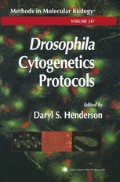Abstract
Immunostaining of mitotic chromosomes of larval neuroblasts by antibodies directed against specific proteins is a powerful tool for analyzing their distribution in both euchromatin and heterochromatin. This approach is particularly important for the structural analysis of heterochromatin because the high content of repetitive DNA and the absence of meiotic recombination render this material difficult to manipulate by standard genetic and molecular methods. Sensitive chromosome banding techniques have elaborated a cytogenetic map of Drosophila melanogaster heterochromatin (1,2), which is now resolved into 61 distinct bands designated h1–h61 (see Chapter 16). The relationship between these bands and the locations of 30 genetically defined heterochromatic loci, the major satellite DNA clusters, and 12 different middle repetitive DNA families have been determined (3,4).
Access this chapter
Tax calculation will be finalised at checkout
Purchases are for personal use only
References
Gatti, M., Pimpinelli, S., and Santini, G. (1976) Characterization of Drosophila heterochromatin. I. Staining and decondensation with Hoechst 33258 and quina-crine. Chromosoma 57, 351–375.
Pimpinelli, S., Santini, G., and Gatti, M. (1976) Characterization of Drosophila heterochromatin. II. C-and N-banding. Chromosoma 57, 377–386.
Gatti, M. and Pimpinelli, S. (1992) Functional elements in Drosophila melano-gaster heterochromatin. Annu. Rev. Genet. 26, 239–275.
Pimpinelli, S., Berloco, M., Fanti, L., et al. (1995) Transposable elements are stable structural components of Drosophila melanogaster heterochromatin. Proc. Natl. Acad. Sci. USA 92, 3804–3808.
Gatti, M., Tanzarella, C., and Olivieri, G. (1974) Analysis of the chromosome aberrations induced by X-rays in somatic cells of Drosophila melanogaster. Genetics 77, 701–719.
Holmquist, G. (1975) Hoechst 33258 fluorescent staining of Drosophila chromosomes. Chromosoma 49, 333–336.
Pak, D. T. S., Pflumm, M., Chesnokov, I., et al. (1997) Association of the origin recognition complex with heterochromatin and HP1 in higher eukaryotes. Cell 91, 311–323.
Platero, J. S., Csink, A. K., Quintanilla, A., and Henikoff, S. (1998) Changes in chromosomal localization of heterochromatin-binding proteins during the cell cycle in Drosophila. J. Cell Biol. 140, 1297–1306.
Perrin, L., Demakova, O., Fanti, L., et al. (1998) Dynamics of the sub-nuclear distribution of Modulo and the regulation of position-effect variegation by nucleo-lus in Drosophila. J. Cell Sci. 111, 2753–2761.
Deuring, R., Fanti, L., Armstrong, J. A., et al. (2000) The ISWI chromatin-remodeling protein is required for gene expression and the maintenance of higher order chromatin structure in vivo. Mol. Cell 5, 355–365.
Fanti, L., Giovinazzo, G., Berloco, M., and Pimpinelli, S. (1998) The heterochromatin protein 1 prevents telomere fusions in Drosophila. Mol. Cell 2, 527–538.
Huang, D. W., Fanti, L., Pak, D. T., Botchan, M. R., Pimpinelli, S., and Kellum, R. (1998) Distinct cytoplasmic and nuclear fractions of Drosophila heterochromatin protein 1, their phosphorylation levels and associations with origin recognition complex proteins. J. Cell Biol. 142, 307–318.
Author information
Authors and Affiliations
Editor information
Editors and Affiliations
Rights and permissions
Copyright information
© 2004 Humana Press Inc., Totowa, NJ
About this protocol
Cite this protocol
Fanti, L., Pimpinelli, S. (2004). Immunostaining of Squash Preparations of Chromosomes of Larval Brains. In: Henderson, D.S. (eds) Drosophila Cytogenetics Protocols. Methods in Molecular Biology, vol 247. Humana Press. https://doi.org/10.1385/1-59259-665-7:353
Download citation
DOI: https://doi.org/10.1385/1-59259-665-7:353
Publisher Name: Humana Press
Print ISBN: 978-1-58829-050-2
Online ISBN: 978-1-59259-665-2
eBook Packages: Springer Protocols

